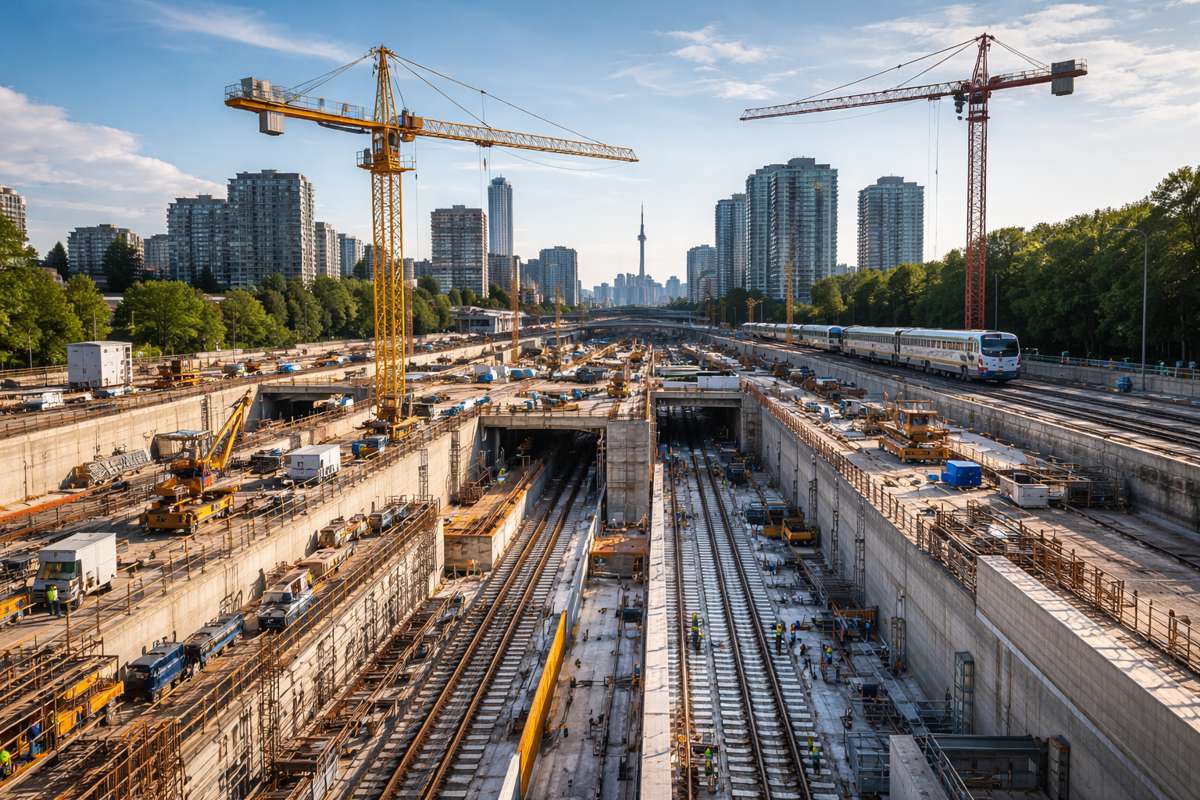Testing soils in construction
Soils form the structural foundation for almost all construction work, making soil testing very important as failure to test soils adequately and correctly would introduce high levels of financial and safety risks.
Before a construction project commences, it is important to know which types of soil underlay the proposed structure. It may be possible to know whether the soil is sand, silt, clay, gravel, peat, rock or loam, without undertaking any testing. However, it is still vitally important to understand the properties of the soil, and to use this information in the planning and design phases of the project. Test data can then be used to ensure that the soil is able to support the proposed structure in the long-term and enable the creation of technical and safety data reports to support planning permissions and licence applications. Furthermore, ongoing testing checks the development of the soil throughout the construction project to ensure quality and safety.
Soil testing should include an assessment of the behaviour of soils under varying conditions of moisture, loading, stress, temperature etc., so that the design can accommodate both current and potential future conditions. The results of geotechnical tests enable design engineers to ensure that foundations are the appropriate type and depth, and that suitable construction materials and methods are employed. Inadequate or improper testing, or failure to implement the results of tests, can lead to costly failures which may also threaten safety and lives.
From a construction perspective, design engineers are mostly interested in the physical characteristics of soils, so a variety of field and laboratory geotechnical tests are undertaken, and in the following article Adeel Hassan, from test equipment manufacturer ELE International, will outline the most important tests and provide an overview of the latest test methods.
Standard Soil Testing Methods
In order to ensure the uniformity, reliability and accuracy of materials testing, a large number of internationally accepted test standards have been developed. These standards ensure that test results are comparable and apply equally wherever the testing is conducted. Test equipment has therefore been developed to meet the needs of these methods, and manufacturers such as ELE have published sets of equipment for each of the standard test methods, available in the Buyers’ Guide sections of the ELE catalogue.
In-situ Sampling & Preparation
The correct sampling, description and preparation of soil and soil mixtures is necessary if subsequent tests are to be meaningful and provide representative results. The choice of sampling equipment will depend on the tests to be undertaken and the type of soil to be sampled. For example, cohesive soils necessitate a different auger head to sands and gravels, and auger extensions facilitate the collection of samples from different depths. Sample tubes, extruder kits and soil lathes are necessary where a soil core of a specific diameter is to be collected for subsequent examination and testing. Specimen Trimmers enable the precision trimming of soil samples for triaxial, shear, unconfined compression, and other tests requiring standard cylindrical specimens.
Most test standards specify a recommended maximum particle size and this can be achieved with sample dividers known as riffle boxes. For most tests, crushing of soils is to be avoided or minimised, but where necessary, manual and mechanical equipment is available for this purpose.
Moisture Content
The measurement of moisture content is probably the single most important geotechnical test and has the advantage of being equally valid on disturbed and undisturbed samples. Moisture content can be assessed in the field, or in the laboratory, but opportunity for error exists where samples are not representative or when sampling and storage procedures do not preserve the moisture content prior to testing.
The portable Speedy Moisture Tester employs a technique based on the fact that water reacts with calcium carbide to form a gas, and that the quantity of gas formed is directly proportional to the amount of water present. A soil sample is weighed on a portable balance and following a test, the percentage moisture content is read directly from the instrument’s calibrated pressure gauge. There are three versions of the ELE Speedy Moisture Tester for measuring 6, 8 or 20 gram samples.
The standard method for determining the moisture content of soil is the Oven Drying Method, in which the moisture content is defined as the mass of water which can be removed from the soil, usually by heating at 105-110 DegC, expressed as a percentage of the dry mass of soil.
Soil Index Properties
The plastic limit is defined as the lowest moisture content of a soil that will permit a sample to be rolled into threads of 3 mm diameter without the threads breaking. This soil testing procedure requires simple, basic equipment and has remained largely the same since 1932.
Soil condition can be altered by changing the moisture content. The liquid limit is the empirically established moisture content at which a soil passes from the plastic to the liquid state. By establishing the liquid limit, engineers are able to correlate several engineering properties for the soil. Two main types of test are used; the Casagrande
type Cup (liquid limit device: motorised or hand-operated) and the cone penetrometer method, which is now the definitive method specified in BS 1377.
The cone penetrometer method determines the liquid limit value by measuring the relationship between moisture content and the penetration of a cone into the soil sample under controlled conditions. The device is available as a manual or semi-automatic version.
When the water content of a fine-grained soil is reduced below the plastic limit, shrinkage continues until the shrinkage limit is reached. Shrinkage can be significant in clays but less so in silts and sands. To assess these characteristics, test equipment is available to determine parameters such as shrinkage ratio, volumetric shrinkage and linear shrinkage.
Particle density or specific gravity is used to calculate porosity and voids ratio and is particularly important when compaction and consolidation properties are being investigated. Particle density depends on the composition of both the mineral and the organic soil components and is defined as the ratio of the mass of the particles to the mass of the water they displace. For soils containing up to 10% of particles retained on a 37.5 mm BS sieve, this can be determined with a gas jar and an end-over-end shaker. Pyknometers are generally suitable for fine-grained soils.
Particle Size Distribution & Sand Equivalent Value
The analysis of soils by particle size provides a useful engineering classification. There are two procedures for this: sieving is used for gravel and sand, and sedimentation is used for the finer soils. For soils containing both coarse and fine particles, a composite test of sieving and sedimentation procedures is usually employed.
The sedimentation method determines particle size distribution in a soil from coarse sand down to clay. The hydrometer test does not require the weighing accuracy necessary for pipette sedimentation and is suitable for use in site laboratories. A mechanical stirrer is necessary in addition to a constant temperature water bath. The hydrometer method measures the specific gravity of the soil solution at various stages of settlement and a Nomographic Chart using Stokes’ Law provides a measurement of particle size. The pipette method requires a pipette and a stand so that samples can be taken at a precise depth.
The Sand Equivalent Apparatus is available as a complete kit for performing a rapid test to show the relative proportions of clay-like or plastic fines and dusts in granular soils and fine aggregates. Providing a consistent and repeatable oscillation, to minimise variation in test results, a mechanical sand equivalent shaker is recommended for use in laboratories performing a large number of tests.
Compaction & CBR
The bearing capacity of soils can be measured in the field or laboratory. However, the physical characteristics of soils can be improved by compaction. Also, many civil engineering projects use soils as fill material, with soil normally being compacted to a dense state to decrease future settlement, increase shear strength and decrease permeability. Compaction can be undertaken by mechanical means such as rolling, ramming or vibrating, and soil testing enables the achievement of optimal compaction at an acceptable cost.
Compaction tests enable an assessment of the moisture content for the most efficient compaction, and the relationship between dry density and moisture content for a given degree of compactive effort, as well as the value of the maximum dry density achieved.
There are several different standard laboratory compaction tests, with the most appropriate depending on the nature of the project, the type of soil and the availability of equipment on site.
The compaction test (sometimes known as the Proctor test) is a laboratory method for determining the optimal moisture content at which a soil will achieve its maximum dry density. These tests involve the compaction of soil at a known moisture content in a cylindrical mould of standard dimensions using a compactive effort of specific weight and frequency (specified in the relevant Standard). The process is repeated for various moisture contents and the dry densities are determined for each. The graphical relationship of the dry density to moisture content is then plotted to create a compaction curve. The maximum dry density is the peak point of the curve and its corresponding moisture content, which is also known as the optimal moisture content. Automatic soils compactors are ideal for this test; eliminating variability between tests and reducing labour and cost. ELE has developed two devices for this application covering both BS/EN and ASTM Standards.
The California bearing ratio test (CBR) compares the load bearing capacity of a soil with that of crushed California limestone. The test was developed for testing soils used for building roads, however, it is also employed in other construction projects. CBR is a penetration test of the mechanical strength of natural ground, subgrades and base courses, and can be performed in the field and in the laboratory on prepared samples.
In the laboratory, a dedicated CBR Test machine can perform tests to BS 1377, EN13286-47 and ASTM D1883. This bench-mounted machine comprises a twin column frame incorporating a motorised drive system. Alternatively, Multiplex machines are able to perform CBR tests as well as other tests on soil and asphalt samples. These machines can be operated with a load cell and dial gauges or with displacement transducers connected to an Automatic Data Acquisition system with a PC running software, such as ELE’s DataSystem DS 7.3, which improves lab efficiency, eliminates operator error and frees staff for other tasks.
CBR tests can also be conducted on-site, and the BS 1377, BS 1924 and ASTM D4429 standards describe in-situ test procedures. On-site testing provides fast results and informs decision making without delaying construction.
Bearing capacity can also be determined in the field with a Plate Bearing Apparatus. This can be applied in designing for static loads on spread footings, and repetitive and non-repetitive plate loading tests of soils and flexible pavements. With 500 kN capacity, this equipment is used in conjunction with a reaction beam.
The TRL (Transport Research Laboratory) Dynamic Cone Penetrometer (DCP) is used for rapid in-situ measurement of the structural properties of existing road pavement constructed with unbound materials, according to ASTM D6951/D6951M. The unit incorporates an 8 kg weight with a drop of 575 mm, and a 20 mm diameter cone fitted to the end of the shaft, allowing measurements to be made down to a depth of approximately 850 mm. Readings are usually taken after a set number of blows, changing the number according to the strength of the layer being penetrated.
Consolidation
Compressible soils can be subject to long-term consolidation under the loads imposed by foundations and above ground structures. Also settlement may occur even if the applied pressure is within the safe bearing capacity of the soil, so it is important to understand this key soil property, particularly if the settlement characteristics beneath an individual structure vary.
The one-dimensional consolidation test is the most common, and sometimes referred to as the oedometer or incremental loading oedometer test. Radially constrained samples are loaded in a sequence starting with a stress close to the over burden pressure of the sample. The loading is then doubled for each stage; typically 4 or 5 times, with a final unloading sequence.
Vertical settlement can be measured with dial gauges or displacement transducers in compliance with the accuracy specified in BS 1377, ASTM D2435 and D4546. Displacement transducers should be supplied with a calibration certificate. As with several other soil tests, it is also possible to manage consolidation tests with an Automatic Data Acquisition system and a PC running software, such as ELE’s DataSystem DS 7.3.
Alternatively, a Pneumatic Consolidation Apparatus utilises a pneumatic load frame to apply loads instantaneously and to maintain a set load, regardless of sample compression. This bench-top instrument is compact and does not require suspended weights.
Permeability
The permeability, or hydraulic conductivity, of a soil depends on the physical and chemical properties of the soil, including particle size distribution, pore space, pore size and the continuity of the spaces.
Permeability is an important soil test in any project where the flow of water through soil is relevant. For example, seepage through or under a dam, drainage from subgrades or backfills, well recharge, and in projects where excavation is undertaken below the water table; necessitating a dewatering plan. Permeability is also a key parameter for the design and assessment of landfill sites, the investigation of contaminated ground, and in the design of earth dams and sheet pile walls.
Soil permeability is measured in the laboratory on intact or reconstituted specimens using constant and falling head methods. Soils containing ≥10% particles passing a 75 μm sieve are tested using the falling head assembly. More granular soils, containing ≥90% particles retained on the 75 μm sieve, are tested using the constant head assembly. The cell is sealed at the top so that a vacuum can be used to saturate the specimen. Porous stones located at the top and bottom of the cell prevent sample flaking or washout.
Permeability tests can also be conducted in the field. The Guelph Permeameter employs a constant head well technique to obtain accurate measurements of hydraulic conductivity, soil sorptivity and soil matrix flux potential.

Soil Strength (Triaxial)
There are two main stages to the soil testing process – consolidation and shearing. In the first stage stresses are applied to mimic those acting on the soil in the field due to the weight of overlying strata or structures. In the second stage an additional stress is applied to reach peak failure and beyond, under specific drainage conditions. The additional stress applied to the specimen should correspond to the field loading situation, including both vertical and horizontal stresses. As a result, it will be possible to determine how much change in load the soil can sustain without failing and how much deformation will occur under normal conditions.
Triaxial soil tests are generally performed on cylindrical specimens by simulating field conditions as closely as possible. Typically, these tests are designed to measure mechanical properties such as stress–strain relations, volume change or pore pressure behaviour, and shear strength of the soil.
The measurement of total stress and effective stress requires different methods and different equipment. Total stresses are normally measured in a triaxial cell where the sample is subject to a confining pressure. A normal load is applied with the sample being confined within a rubber membrane so that no drainage in or out of the specimen is allowed. Pore water pressures are not normally measured, and the undrained test is often referred to as the QU-TXL (Quick Undrained) test.
Effective stresses can be measured in a triaxial cell and include the measurement of back pressure, pore water pressure and volume change; all of which can be used to calculate the required engineering properties. Effective stress soil testing is usually referred to as consolidated drained (CD) or consolidated undrained (CU). Generally the CD test is applicable to sands, while both the CU and CD test can be used with clays.
In order to determine which test equipment is required, a manufacturer such as ELE will need to know:
- Test Standard
- Type of test required (Effective stress, Permeability, Total Stress or Unconfined compression)
- Sample size
- Manual operation (dial gauges) or automatic (software controlled with datalogging)
- Pressure system (oil and water or pneumatic)
- Number of sample cells
It important to employ a de-aired water apparatus when pore pressure measurement is undertaken.

Direct Shear & Vane Tests
The safety of geotechnical structures is dependent upon the strength of the soil; if the soil fails, the structure founded on it can collapse, with catastrophic consequences. The measurement of shear strength is therefore key to the understanding of soil stability.
Soil derives its shear strength from cohesion between particles (stress independent) and frictional resistance between particles (stress dependent). Shear failure occurs when the stresses between the particles are such that they slide over each other, resulting in slippage.
A digital direct/residual shear apparatus conducts shear tests in the laboratory on specimens 60 mm, 100 mm square or 2.5 inches in diameter. A microprocessor controlled drive system enables the operator to set up and run the test, providing speed control and consistency of the soil testing. The first stage of the test in consolidation, after which the specimen is sheared at a constant speed, which is determined by the consolidation stage.
The measurement of horizontal and vertical displacement can be measured with dial gauges or displacement transducers, and as with other soil tests it is also possible to employ an Automatic Data Acquisition system with a PC running software, such as ELE’s DataSystem DS 7.3.
Shear strength can also be measured in the field with an inspection vane kit for testing at the soil surface or in a test pit. The vane shear test is an in-situ geotechnical testing method used to estimate the undrained shear strength of undisturbed soils. A similar vane apparatus has been developed by TRL for testing samples in the laboratory. In addition, ELE also provides a pocket shearmeter for initial site assessment.
Digital Automatic Testing
ELE develops dedicated software for soil testing to BS, ASTM and AASTHO standards in geotechnical laboratories. The latest version (DS 7.3) contains a range of advanced features including compatibility with Microsoft Windows 10, Office 2016 and 365.
Providing the ability to automate data logging, analysis and reporting, DS 7.3 improves the quality and productivity of soil tests such as Triaxial, Permeability, Consolidation, Direct/Residual Shear and CBR. The DataSystem software has been the workhorse of soils testing laboratories around the world for many years, and this new version helps improve lab efficiency, eliminate operator error and it frees staff for other tasks.
In conjunction with ELE’s DSU Electronic Data Acquisition Unit or the GDU, the DS 7.3 software enables accurate and repeatable tests by providing step-by-step instructions and by preventing potential errors from manual readings. With Ethernet communications the software is simple to run and provides 24-hour unsupervised logging. Reports are generated automatically in accordance with the chosen Standard and real-time graphical outputs can be viewed on-screen and printed.
Conclusion
In the construction industry, soil failure can result in minor low cost issues such as cracking which may have only aesthetic consequences. However, history is littered with examples of failures that have resulted in disasters that have caused enormous financial cost and in some cases, the loss of lives.
Most soil testing is simple and inexpensive, and they can inform decision making and planning, so a small investment in testing can protect safety and avoid the enormous costs of failure.




















